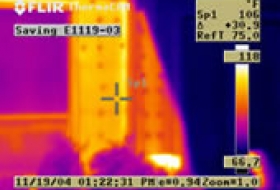Thermography is the simplest way to find utility lines before you dig on your property, but this innovate technology is also suitable for a range of other applications. As part of your regular home maintenance, infrared thermography and GRP technology alerts you to problems like improperly sealed windows and water leaks. With regular inspections using this technology, you can enjoy an energy-efficient, well-maintained home.
Pinpointing Energy Loss
Infrared thermography scans are a simple, efficient way to determine where energy loss occurs in your home. Infrared thermography pinpoints energy loss by identifying significant temperature variations inside or outside the home. When you know exactly where temperature variations occur, you can easily create a precise plan for sealing and insulating your home to prevent energy loss.
To prepare for the inspection, pull furnishing away from the walls and remove curtains or shades to expose the windows. This step makes it easier to identify variations in temperature along walls and around windows. You should plan the inspection during the winter months if live in a region with cold winters, or in the summer if you live in an area with mild winters and very hot summers.
Outdoor Maintenance
Ground penetrating radar, or GPR, allows you to examine your property, including concrete surfaces, for potential problems. Ground penetrating radar can detect weak concrete, allowing you to replace or repair the material before it begins cracking or crumbling. You should also scan your property with GPR before you install outdoor structures to map the location of utility lines and underground structures.
Electrical Inspections
Infrared thermography is an easy way to inspect your electrical system. The inspection includes checking the electrical system for warm areas, which usually indicate an improperly installed or malfunctioning wire or breaker. Broken circuits, open circuits and corrosion is also identified during the inspection. An electrical system inspection is a must-have when you are buying a new home, or if you live in a historic home that may have old or outdated wiring.
Inspections are also recommended every three to five years as part of your regular home maintenance. Maintenance inspections identify potential problems early so you can avoid serious problems, such as power outages caused by broken circuits. Regular electrical system assessments also help reduce the risk of electrical fires caused by malfunctioning or overloaded circuits.
Identifying Ventilation Problems
Infrared thermography can help you identify ventilation problems. Improper ventilation is particularly common in bathrooms, laundry rooms and kitchens, but can happen anywhere in the home. Improper ventilation can cause damp spots on walls and ceilings, creating the perfect conditions for mold and mildew growth. An infrared thermography assessment tells you exactly where to install additional ventilation for healthier indoor air.
Roof Maintenance and Repairs
Just one damaged shingle can cause significant moisture damage inside your home. Infrared thermography is especially helpful if you have noticeable water damage inside your home, but can’t locate the source of the leak. Both interior and exterior roof scans are available. Interior scans locate wet materials in the attic or walls to expose the source of the leak, while exterior scans locate small pockets of water under the shingles.
An infrared thermography scan is very useful if you are buying a home and want to avoid expensive roof repairs. For homeowners, annual or bi-annual roof inspections help prevent damage to the underlying structure of your home, reducing maintenance and repair costs over time. With ground penetrating radar and infrared thermography, you can take preventative steps to prevent the need for serious repairs.
You can contact us by using the form on our website or calling us at (972) 724-5550

